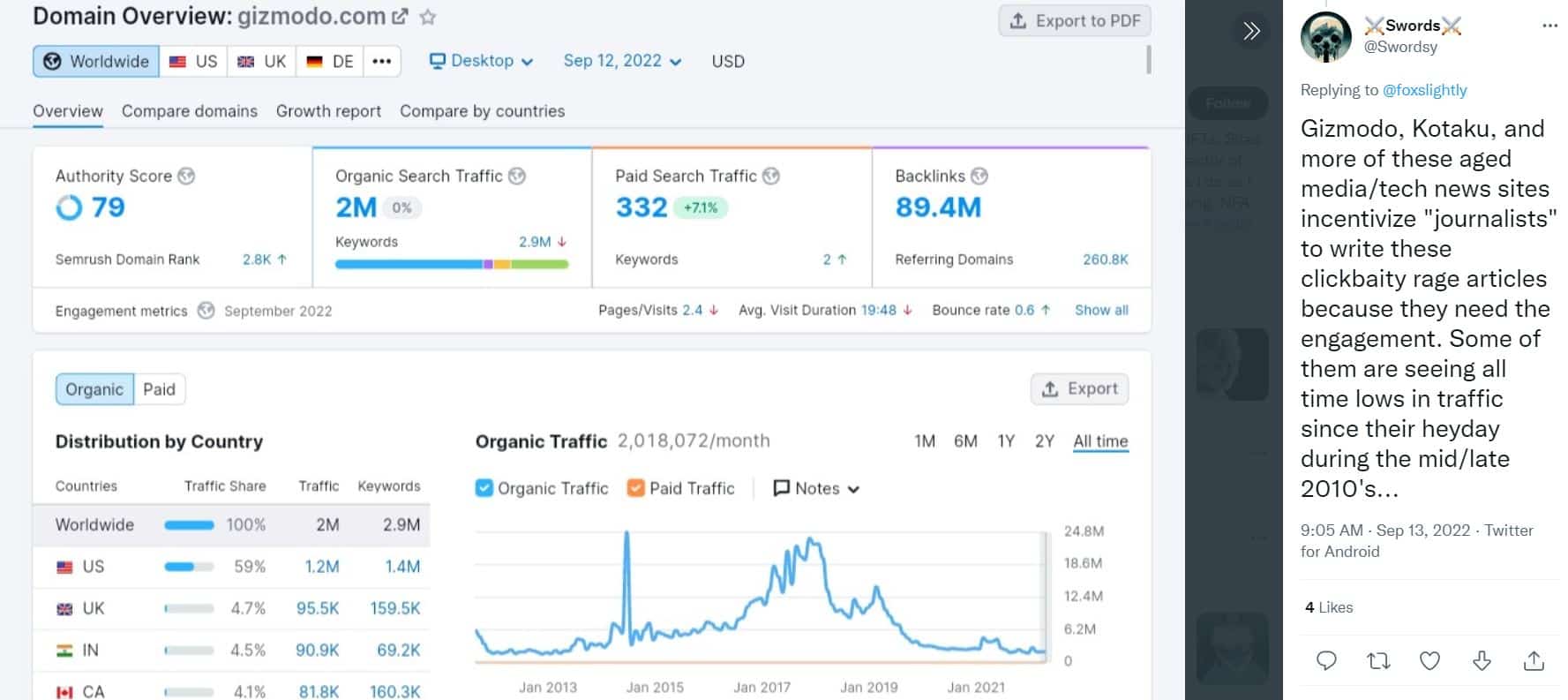Gizmodo is attracting attention in the NFT space, but for all the wrong reasons. Surprisingly, the editorial line seems to always criticise NFTs. Following headlines such as “Starbucks Explains How Its Dumbass NFT Program Works” and “Tiffany & Co. Released NFTs (and They’re Ugly)”, Gizmodo has been raising eyebrows.
Undoubtedly, tech heads have been wondering why Gizmodo, a tech website, seems to hate NFTs so much. So if you’ve also been questioning this NFT negativity, here’s some insight into why this might be the case.

Image credit: Press Gazette
A deep dive into the reasons for Gizmodo’s editorial line:
Controversial headlines create more engagement
As @Swordsy pointed out: “Gizmodo, Kotaku, and more of these aged media/tech news sites incentivize “journalists” to write these clickbaity rage articles because they need the engagement. Some of them are seeing all time lows in traffic since their heyday during the mid/late 2010s.”
Indeed, since the mid-2010s, the internet exploded with new websites relating to emerging technologies, such as crypto and NFTs. Additionally, nowadays, an increasingly democratised media landscape means that everyone – and not only corporate or private equity behemoths – can start a successful media company. Therefore, chasing eyeballs in an oversaturated news landscape can lead to media and tech news sites like Gizmodo opting for clickbaity headlines.

Early adoption is not for everyone
Another reason for such an editorial line is the fact that early adoption is not for everyone. Surprisingly, being a tech website editor does not correlate to being an early adopter.
According to the diffusion of innovation theory, innovation is not adopted by everyone at the same time. The diffusion of innovation theory divides adopters into different categories, namely innovators, early adopters, early majority, late majority, and laggards.
Furthermore, according to Everett Rogers’ theory: “Early adopters use the data provided by the innovators’ implementation and confirmation of the innovation to make their own adoption decisions. If the opinion leaders observe that the innovation has been effective for the innovators, then they will be encouraged to adopt.”
Overall, NFTs are still a relatively new technology – with all the problems and benefits that come with new technologies. Therefore, the challenges that come with new technologies might be one reason why tech websites like Gizmodo opt for a negative stance.
The Negativity Bias
According to the negativity bias, negative things have a greater impact on an individual’s psychological state. This also relates to negative headlines and news. Seemingly bad news attracts more clicks. As a result, this leads search engines to pick up the pattern and show this article to more people. Needless to say, the cycle continues. To summarise: an increase in clicks correlates to an increase in traffic, leading to the article appearing higher on the search engine results page.
To sum up, it is safe to say that these could all be reasons tech media like Gizmodo opt for blanket negative headlines for all NFT projects. Therefore, always keep in mind that there is more than one factor at play when reading your next article.
All investment/financial opinions expressed by NFTevening.com are not recommendations.
This article is educational material.
As always, make your own research prior to making any kind of investment.









 Bitcoin
Bitcoin  Ethereum
Ethereum  Tether
Tether  XRP
XRP  Solana
Solana  Dogecoin
Dogecoin  USDC
USDC  Cardano
Cardano  Lido Staked Ether
Lido Staked Ether  TRON
TRON  Avalanche
Avalanche  Sui
Sui  Wrapped stETH
Wrapped stETH  Toncoin
Toncoin  Chainlink
Chainlink  Stellar
Stellar  Shiba Inu
Shiba Inu  Wrapped Bitcoin
Wrapped Bitcoin  Hedera
Hedera  Polkadot
Polkadot  WETH
WETH  Bitcoin Cash
Bitcoin Cash  LEO Token
LEO Token  Hyperliquid
Hyperliquid  Uniswap
Uniswap  Litecoin
Litecoin  Pepe
Pepe  Wrapped eETH
Wrapped eETH  NEAR Protocol
NEAR Protocol  Ethena USDe
Ethena USDe  USDS
USDS  Internet Computer
Internet Computer  Aptos
Aptos  Aave
Aave  Mantle
Mantle  Cronos
Cronos  Render
Render  POL (ex-MATIC)
POL (ex-MATIC)  MANTRA
MANTRA  Bittensor
Bittensor  Ethereum Classic
Ethereum Classic  Monero
Monero  WhiteBIT Coin
WhiteBIT Coin  Virtuals Protocol
Virtuals Protocol  Artificial Superintelligence Alliance
Artificial Superintelligence Alliance  Dai
Dai  Tokenize Xchange
Tokenize Xchange